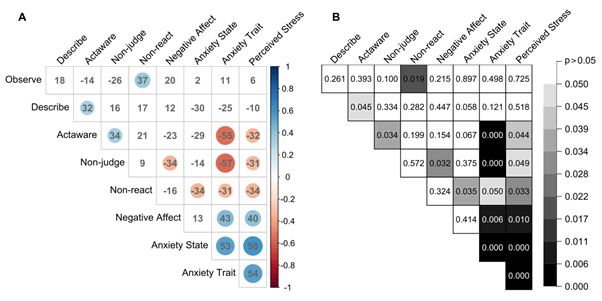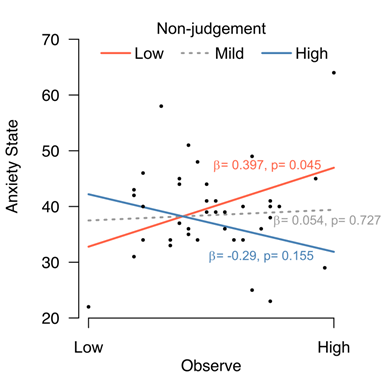Research Article - (2022) Volume 8, Issue 1
Received: 07-Feb-2022, Manuscript No. ipcp-22-12520; Editor assigned: 09-Feb-2022, Pre QC No. ipcp-22-12520 (PQ); Reviewed: 23-Feb-2022, QC No. ipcp-22-12520; Revised: 28-Feb-2022, Manuscript No. ipcp-22-12520 (R); Published: 07-Mar-2022, DOI: 10.36648/2471-9854.8.1.121
Background: In this paper, we investigate how dispositional attentional quality is present, and its correlation with measures of well-being, in university student’s naïve in meditation practice.
Methods: A total of 40 students (20 females) were asked to fill self-reported measures of stress, anxiety, affect, and dispositional mindfulness.
Results: Negative correlations between some mindfulness facets and perceived stress, anxiety, and negative affect were found. The Non-judgement facet moderated the relationship between Observe and state anxiety, in which mild and high non-judgement levels prevent their positive relationship.
Conclusion: Attentional quality in non-meditating university students seem to be important in regulating the ongoing experience of anxiety.
Trial registration: http://www.ensaiosclinicos.gov.br/rg/RBR‑7b8yh. Identifier: ReBEC, U1111‑1194‑8661 (Date of registration: July 8th, 2018).
Dispositional mindfulness; Attentional quality; Mindfulness facets; Moderation analysis
Attention processes are often trained in meditative practices, such as in mindfulness-based programs, and facilitates cognitive flexibility, emotional regulation, and metacognition [1]. In contrast, other studies have found a positive relationship between attentional skills, such as the Observe facet from the Five Facets Mindfulness Questionnaire (FFMQ), and psychopathological symptoms, including depression, anxiety, and substance use [2,3].
Further analyses have shown that the relationship between Observe and psychopathological symptoms is dependent on how individuals observe. When the observing is free of judgement and reactivity, the association is no longer toward the symptoms, suggesting that it is not just about paying attention but rather it involves the quality of the experienced awareness [2,3]. In fact, according to Jon Kabat-Zinn, founder of the Mindfulness Based Stress Reduction program, mindfulness involves “attending to relevant aspects of experience in a nonjudgemental manner” [4].
In aiming to investigate whether attentional quality as a dispositional feature is present in university students naïve in meditation practice, we first evaluated how FFMQ facets correlate with self-reported measures of affect and stress, and then whether the Observe facet interacts with either Non-judgement (Non-judge) and/or Non-reactivity facets to change the relationship between Observe and the measures of affect and stress.
The sample consisted of 40 graduate and undergraduate students (20 females, 24.15 ± 3.61 years old) from the Federal University of Rio Grande do Norte (UFRN) with no previous experience with meditation or yoga. Individuals were right-handed and declared not having psychiatric disorder diagnosis or no prescription for any psychotropic or anti-inflammatory near or at the day of data acquisition [5]. All procedures were approved by the UFRN ethics committee (#1,761,383).
Measures
The participants filled out self-report measures of affect, anxiety, and stress. Negative Affect (NAS), anxiety and stress were assessed by the Positive and Negative Affect Schedule (PANAS), the State and Trait Anxiety Inventory (STAI), and the Perceived Stress Scale (PSS). Dispositional Mindfulness was evaluated by the FFMQ. It comprises five facets: Observe (attending to internal and external experiences), Describe (labeling the experiences), Act with Awareness (Actaware, paying attention to ongoing activity, in contrast to the automatic pilot), Non-judgement (non-evaluative attitude towards thoughts and feelings), and Non-react (disengaging thoughts and feelings, allowing them to come and go) [6]. For a detailed explanation and properties of these psychometric instruments for our sample see [5].
Statistical analysis
Correlations between variables were assessed using the Spearman’s correlation test. We performed a simple moderation analysis to evaluate the interaction between facets to test whether the effect between two variables depends on the specific levels of a third one, the so-called moderator. Once the interaction is found, the slope for each level of the moderator (Low=1 standard deviation below the mean, Mean/mild=mean level, High=1 standard deviation above the mean) is calculated. Here in, we evaluated Non-react and Non-judgement as moderators for the relationship between Observe and the measures of affect, anxiety, and stress. Before the analysis, the variables were z-transformed to avoid multicollinearity and to get standardized estimates of the slope (β).
All analyzes were performed in the R software (4.0.3) using the RStudio IDE (1.4.1103). Statistical significance was established at p ≤ .05.
Except for Observe and Describe, facets negatively correlated with Trait Anxiety (Act with awareness: rs=- .55, p<.001; Nonjudge: rs=- .57, p<.001; Non-react: rs=- .31, p=.049) and Perceived Stress (Act with awareness: rs=- .32, p=.044; Non-judgement: rs=- .31, p=.049; Non-react: rs=- .34, p=.032). In addition, Non-judgement correlated with Negative Affect (rs=- .34, p=.032), and Non-react with State Anxiety (rs=- .34, p=.035) (Figure 1).

Figure 1: Matrices of correlation coefficients (in %) (A) and p-values (B) of Spearman’s correlation test. Circles represent the strength of significant correlations in (A). Actaware = Acting with awareness, Non-judge = Non-judgement.
An interaction between Observe and Non-judgement was found for predicting State Anxiety (β=- .344, SE=.122, t=-2.81, p=.008) (Table 1). A positive relationship between Observe and Anxiety was specifically found when the levels of Non-judgement were low (β=.397, SE=.192, t=2.07, p=.045), but it was lost at mild (β=- .054, SE=.152, t=.352, p=.727) and higher Non-judgement levels (β=- .290, SE=.199, t=-1.45, p=.155) (Figure 2). No interaction was found for the other measures (Table 1).

Figure 2: Interaction plot showing the positive relationship between Observe and State Anxiety at low Non-judgement levels, and the lack of relationship at mild and high of Non-judgement levels.
Table 1: Interaction analyses between Observing and Non-react/Non-judgement. NAS=Negative Affect Schedule, SAI=State Anxiety Inventory, TAI=Trait Anxiety Inventory, PSS=Perceived Stress Scale, SE=standard error.
| β | SE | 𝑡 | p-value | ||
|---|---|---|---|---|---|
| NAS | Observing x Non-react | 0.104 | 0.176 | 0.593 | 0.557 |
| Observing x Non-judge | 0.187 | 0.122 | 1.54 | 0.132 | |
| SAI | Observing x Non-react | -0.249 | 0.166 | -1.5 | 0.141 |
| Observing x Non-judge | -0.344 | 0.122 | -2.81 | 0.008 | |
| TAI | Observing x Non-react | -0.055 | 0.171 | -0.321 | 0.75 |
| Observing x Non-judge | -0.161 | 0.115 | -1.4 | 0.169 | |
| PSS | Observing x Non-react | 0.064 | 0.177 | 0.36 | 0.721 |
| Observing x Non-judge | -0.151 | 0.13 | -1.16 | 0.252 |
Dispositional mindfulness has been shown as a protective factor against distress measures and may act as a resilience-promoting factor [7]. Our aims were to assess the relationship between the facets of the Five Facets of Mindfulness Questionnaire (FFMQ) and affect, anxiety, and stress measures, and explore the influence of attentional quality in a sample of non-meditators.
We found moderate negative correlations between Act with Awareness, Non-judgement and Non-react with anxiety and stress. Interestingly, these are facets related to the present-moment attention, and the non-elaborative and acceptance domains of dispositional mindfulness, respectively [8]. Therefore, it seems that dispositional mindfulness skills are mainly expressed through attentional quality in non-meditators.
In addition, we found that Non-judgement acts as a moderator of the relationship between Observe and State Anxiety, in which high Non-judgement levels protect against its positive relationship. This finding corroborates others showing that Observe can be associated with anxiety symptoms [9]. Indeed, according to the attentional quality hypothesis, observing without an attitude of non-judgement of the inner experience can lead to self-identification with negative feelings, as observed in depressed patients, compared to healthy subjects [10]. In other words, it is not enough to pay attention if it is not accompanied by a non-elaborative attitude towards the feelings and emotions being observed.
This study has some limitations associated with the small number of participants, and a homogeneous sample which restricts generalizing the results. However, the results replicated similar findings evaluated in clinical samples and university students in a healthy meditation naïve sample, and reinforce the relevance of cultivating quality in attention [2,3].
In summary, these results show that attentional quality is essential even in healthy non-meditators, at least concerning moderating the anxiety symptoms experienced at the moment.
The authors are thankful to the participants, as well as to Higher Education Improvement Coordination (CAPES) and Brazilian Council for Scientific and Technological Development (CNPq) for financial support.
The authors report no conflicts of interest.
GMSJ and GLLA were supported by Higher Education Improvement Coordination (CAPES) under Grants 88882.376039/2019‑01 and 88887.353476/2019-00, respectively. MBCS was supported by Brazilian Council for Scientific and Technological Development (CNPq) under Grant 484972/2013‑8 and 306051/2017-6.
The dataset and the script file with all the analyses can be found at https://doi.org/10.17605/OSF.IO/MVCFU.
[Cross Ref] [PubMed] [Google Scholar]
[Cross Ref] [PubMed] [Google Scholar]
[Cross Ref] [PubMed] [Google Scholar]
[Cross Ref] [PubMed] [Google Scholar]
[Cross Ref] [PubMed] [Google Scholar]
[Cross Ref] [PubMed] [Google Scholar]
[Cross Ref] [PubMed] [Google Scholar]
[Cross Ref] [PubMed] [Google Scholar]
[Cross Ref] [PubMed] [Google Scholar]
[Cross Ref] [PubMed] [Google Scholar]
Copyright: This is an open access article distributed under the terms of the Creative Commons Attribution License, which permits unrestricted use, distribution, and reproduction in any medium, provided the original work is properly cited.